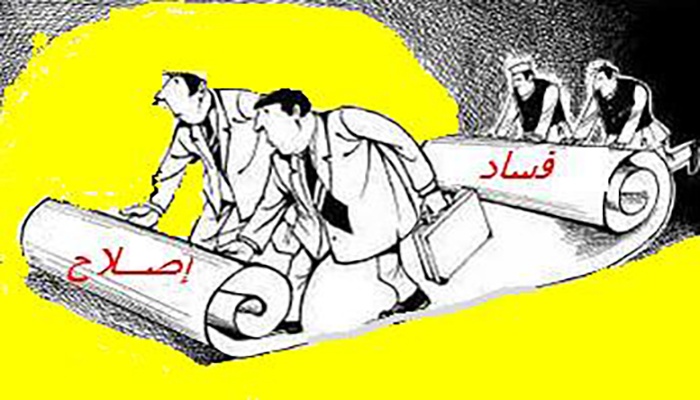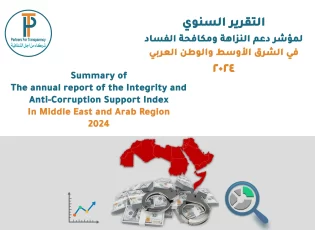The first annual report - Book of the state of corruption in Egypt
(July 2015 - June 2016)
Supply and local authorities witness half of the corruption incidents during the past year
During a whole year (July 2015 - June 2016), Partners for Transparency monitored the phenomenon of corruption in Egypt, and issued 12 monthly reports within the framework of the Corruption Status Book series. These reports included a compilation of the corruption incidents that were revealed, and their classification according to the different sectors. As well as its classification according to the judicial position of each, and also according to its geographical spread.
Through this first annual report, Partners for Transparency provides a compilation and analysis of the facts that have been monitored during the whole year, as well as a tracing of the most important facts that have had a wide resonance in the Egyptian society, as well as a monitoring of the most important legislative and procedural developments and political positions related to the issue of combating corruption during the period From July 2015 until June 2016.
First: Evolution of the legislative and procedural environment (July 2015 - June 2016):
The fight against corruption depends strongly on the strength of legislation and the strictness of its implementation, which was absent from the scene during that period, as the legislative role was absent due to the absence of parliament during the period from July 2015 until mid-January 2016, and the parliament, after its session, was busy preparing its basic regulations, then approving the legislation issued in His absence, as he did not clearly discuss laws for combating corruption, and during the process of forming Parliament's specific committees, he rejected a proposal to form a committee to combat corruption.
The last period has revealed that Egypt is facing the problem of the existence of many weak laws that need to be reformulated in order to be able to curb the phenomenon of widespread corruption in institutions. The urgent need for the necessity to expand the powers, achieve independence and raise the efficiency of relevant regulatory institutions, which is consistent with the provisions of the 2014 constitution. Not yet reflected in concrete steps.
During the period covered by the report, a controversial decision was issued by the President of the Republic, which is the decision by Law No. 89 of 2015 to dismiss the heads of regulatory agencies and bodies, taking into account the public interest, when one of these loses the conditions for his continuity in the position, and this is the decision that the president relied on in the preparation for the dismissal of the former head of the Central Auditing Organization Hisham Geneina after the crisis of his statements about the cost of corruption in Egypt, which was later refuted by a committee formed from officials of some other regulatory bodies, an issue whose effects still interact so far between supporters and opponents.
It should be noted here that the past year witnessed widespread moves by the Administrative Control Authority, which seized several corruption cases in which some senior officials were involved, and there are many evidences indicating that this supervisory body receives remarkable political support, to the point that the president assigned it to form a technical committee to evaluate the projects it implements The state.
Despite the shortcomings of the legislative and procedural steps during the past year, the same period witnessed momentum at the level of political statements and positions related to combating corruption, as it was evident in the speeches and statements of the President of the Republic the interest of the Presidency in adopting a political discourse emphasizing the fight against corruption and urging citizens, ministers, and conservatives to fight corruption and advertising About the state’s interest in fighting corruption, and many ministers and governors made the same statements.
The period from July 2015 to June 2016 witnessed some ministries taking limited steps to create internal mechanisms to combat corruption, which are mechanisms that there is no evidence that they are of tangible effectiveness, as some ministries, bodies and governorates have formed anti-corruption committees from the employees of these ministries. Among the meetings, seminars and training workshops related to combating corruption, the month of June 2016 witnessed the launch of a massive advertising campaign urging officials and citizens to reject corruption.
Second: The distribution of corruption incidents according to sectors for the period from July 2015 until June 2016
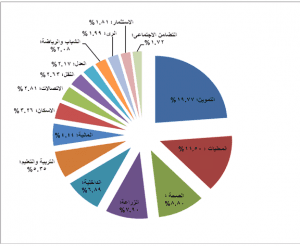
The previous data indicate the distribution of corruption incidents according to sectors during the period from July 2015 to June 2016, which recorded 1,102 incidents of corruption in state institutions, where the Ministry of Supply won the largest share of corruption incidents with 215 incidents, a percentage of 19.77% out of a total of 1,102 incidents, followed by localities with a score of 127 Corruption incidents of approximately 11.5%, then Health with a score of 97 incidents of corruption of 8.8%, then the Ministry of Agriculture with a score of 88 incidents of 7.9%, followed by the Ministry of Interior with a score of 76 incidents of 6.89%, followed by the Ministry of Education with 59 incidents of corruption of 5.35%, then The Ministry of Finance with a score of 49 incidents with a score of 4.44%, then the Ministry of Housing with a score of 36 incidents with a score of 3.26%.
This is followed by the Ministry of Communications and Information Technology with a score of 31 incidents with a score of 2.8%, the Ministry of Transport with 29 incidents of 2.63%, the Ministry of Justice with a score of 24 incidents of 2.17%, then the Ministry of Youth and Sports with a score of 23 incidents of 2.08%, followed by the Ministry Irrigation and Water Resources with a score of 22 incidents of 1.99%, then the Ministry of Investment with a score of 20 incidents of 1.81%, then the Ministry of Social Solidarity with a score of 19 incidents of 1.72%, then the Ministry of Petroleum and the Ministry of Awqaf came with a score of 18 incidents of corruption for each of them at a rate of 1.6%, Both the Ministry of Higher Education and the Ministry of Antiquities had a score of 17 incidents with a ratio of 1.54%, then the Ministry of Electricity came with a score of 14 incidents with a ratio of 1.27%, followed by the regulatory agencies with a score of 12 incidents of corruption with a ratio of 1.08%, and investment with 18 incidents, while the Ministry of Higher Education followed them with 16 incidents. This is followed by the Ministry of Antiquities and Electricity with 16 incidents, the Ministry of Solidarity with 13 incidents, followed by the regulatory agencies with 11 incidents, then the private sector, Parliament and the Radio and Television Union came with 10 incidents each at a rate of 0.90%, then The Ministry of Culture comes with 9 incidents with a rate of 0.81%, then the Ministry of Information comes with 8 incidents of 0.72%, followed by each of the Presidency and the Ministry of Industry and Trade with 7 incidents of 0.63%, then the Prime Minister comes with 6 incidents of corruption of 0.54%, followed by The Ministry of Environment with a score of 5 incidents with a score of 0.45%, followed by both the businessmen sector and the Ministry of Manpower with a score of 0.36%, and the Ministry of Aviation and the Ministry of Tourism got 3 incidents of corruption with a rate of 0.27%, then the Judicial Authority obtained two incidents of corruption with a rate of 0.18% Finally, economic authorities, public figures and the Ministry of Urban Development come with a score of 1 out of 1,102 corruption incidents, with a rate of 0.09%.
Third: The distribution of corruption incidents according to the case's position throughout the year
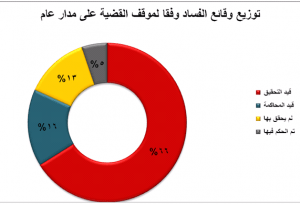
The previous data indicate the distribution of corruption incidents according to the status of the case during the period from July 2015 until June 2016, as the incidents under investigation received the largest share of the number of incidents, as 728 corruption incidents were recorded out of a total of 1,102 incidents, with a percentage of 66%, while the cases under trial recorded 173 incidents, a percentage of 16 % Then came the incidents that were not investigated with a score of 144 incidents with a percentage of 13TP1T, and came in the last place the incidents that were judged with a score of 57 incidents with a percentage of 5% out of a total of 1,102 incidents of corruption over the course of 12 months.
Fourth: The monthly distribution of corruption incidents:
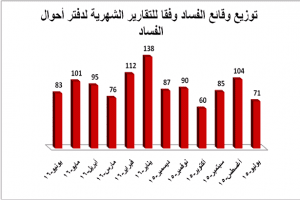
The data prior to the monthly distribution of corruption cases indicate that January 2016 recorded the highest rate of corruption incidents with 138 incidents, immediately followed by February of the same year with 112 incidents, then August 2015 with 104 incidents, and May 2016 with 101 incidents, while October 2015 was It is the lowest with a score of 60 corruption incidents.
Short link: https://pfort.org/en/?p=1486

